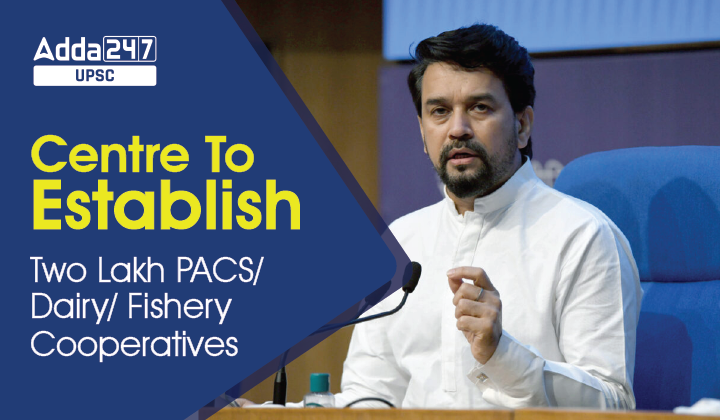Table of Contents
Centre To Establish Two Lakh PACS/ Dairy/ Fishery Cooperatives:
In this article, ”Centre To Establish Two Lakh PACS/ Dairy/ Fishery Cooperatives”, we will discuss about Primary Dairy Cooperative Societies(PDCSs), Primary Dairy Cooperative Societies(PDCSs), Primary Fishery Cooperative Societies(PFCSs), Brief Info About Cooperative Movement In India, etc.
Context Of PACS/ Dairy/ Fishery Cooperatives
In News
The Union Cabinet on February 16, 2023, approved the plan to establish around 2 lakh:
- Primary Agricultural Credit Societies (PACS) in each uncovered Panchayat;
- Viable dairy cooperatives in each uncovered Panchayat; and
- Viable fishery cooperatives.
These PACS/dairy/fishery cooperative societies will be established in each Village Panchayat, coastal Panchayat as well as Panchayat/village having large water bodies, and strengthening the existing PACS/dairy/fishery cooperative societies.
Brief Info About PACS/ Dairy/ Fishery Cooperatives In India
Primary Agricultural Credit Societies (PACSs)
- Primary Agricultural Credit Societies (PACS) are around 98,995 in number.
- Having a member base of 13 crore.
- Constitute the lowest tier of the Short-Term Cooperative Credit (STCC) structure in the country.
- What PACSs Do? Provides short-term and medium-term credit and other input services, like seed, fertilizer, pesticide distribution, etc. to member farmers.
- How PACSs Refinanced? These are refinanced by NABARD through 352 District Central Cooperative Banks (DCCBs) and 34 State Cooperative Banks (StCBs).
Primary Dairy Cooperative Societies(PDCSs)
- Primary dairy cooperative societies, around 1,99,182 in number.
- Having around 1.5 crore members.
- What PDCSs Do? Primary Dairy Cooperative Societies(PDCSs) are engaged in procurement of milk from the farmers, providing milk testing facilities, cattle feed sale, extension services, etc. to the members.
Primary Fishery Cooperative Societies(PFCSs)
- Primary fishery cooperative societies, around 25,297 in number.
- Having around 38 lakh members.
- What PFCSs Do? Primary Fishery Cooperative Societies(PFCSs) cater to one of the most marginalized sections of the society, providing them marketing facilities, assisting in procuring fishing equipment, fish seed and feed, and also providing credit facilities to the members on a limited scale.
About Primary Agricultural Credit Societies (PACSs)
Village Level Cooperative Credit Societies
- Primary Agricultural Credit Societies (PACSs) are village level cooperative credit societies that serve as the last link in a three tier cooperative credit structure headed by the State Cooperative Banks (SCB) at the state level.
Where Credit Goes?
- Credit from the SCBs is transferred to the district central cooperative banks, or DCCBs, that operate at the district level. The DCCBs work with PACS, which deal directly with farmers.
How PACSs Working?
- A report published by the Reserve Bank of India on December 27, 2022 put the number of PACS at 1.02 lakh.
- At the end of March 2021, only 47,297 of them were in profit.
- The same report said PACS had reported lending worth Rs 1,43,044 crore and NPAs of Rs 72,550 crore. Maharashtra has 20,897 PACS of which 11,326 are in losses.
How Will The Plan To Establish Two Lakh PACS/ Dairy/ Fishery Cooperatives Be Implemented?
Plan to establish two lakh PACS/ Dairy/ Fishery Cooperatives will be implemented with the support of:
- NABARD
- National Dairy Development Board (NDDB) and
- National Fisheries Development Board (NFDB)
Plan to establish two lakh PACS/ Dairy/ Fishery Cooperatives will be implemented through convergence of various schemes of Ministry of Fisheries, Animal Husbandry & Dairying by leveraging the ‘whole-of-Government’ approach.
Which Existing Planes Will Be Converged ?
The following schemes have been identified for convergence under the current plan:
Department of Animal Husbandry and Dairying
• National Programme for Dairy Development (NPDD), and
• Dairy Processing & Infrastructure Development Fund (DIDF)
Department of Fisheries
•Pradhan Mantri Matsya Sampada Yojana (PMMSY), and
•Fisheries and Aquaculture Infrastructure Development (FIDF)
Brief Info About Cooperative Movement In India
- Since its formal launch in 1904 in India, the Indian Cooperative Movement has played a very important role in the development of the agriculture and rural sectors combining the strengths of both public and private sector specially in supporting the small and marginal farmers and weaker sections.
- Immediately after Independence in 1947, the Cooperative Sector was recognized by the government as a third economic sector to serve as a balancing factor between the private and public sectors.
- In this way cooperatives developed as a special sector serving the needs of small and marginal farmers and weaker groups.
- At present it is the largest movement in the world.



 TSPSC Group 1 Question Paper 2024, Downl...
TSPSC Group 1 Question Paper 2024, Downl...
 TSPSC Group 1 Answer key 2024 Out, Downl...
TSPSC Group 1 Answer key 2024 Out, Downl...
 UPSC Prelims 2024 Question Paper, Downlo...
UPSC Prelims 2024 Question Paper, Downlo...





